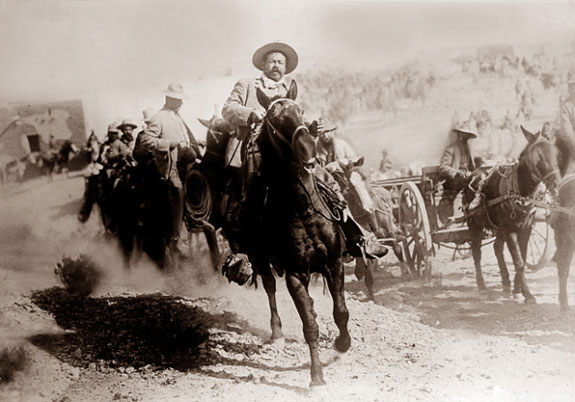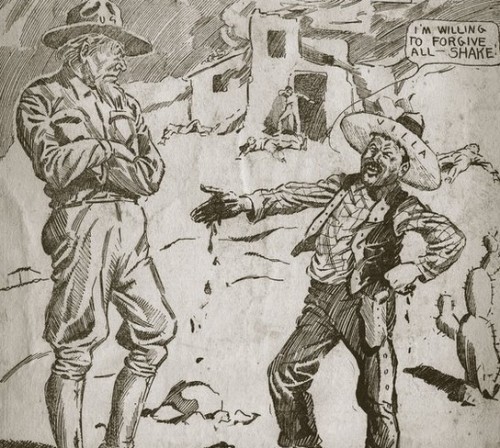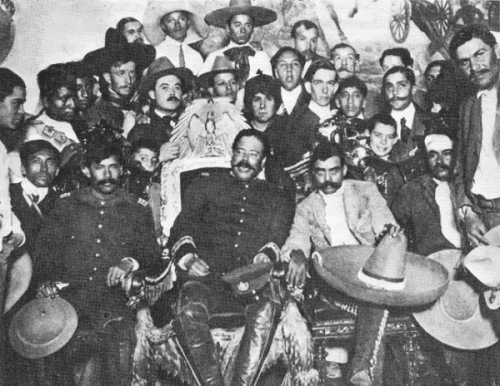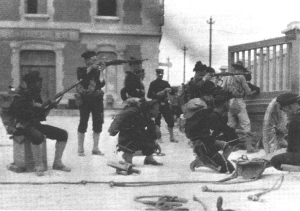Uncovering the Truth Behind the Myth of Pancho Villa, Movie Star
In 1914, the Mexican rebel signed a contract with an American newsreel company that required him to fight for the cameras. Too good to be true? Not entirely
![]()

Pancho Villa, seen here in a still taken from Mutual’s exclusive 1914 film footage. But did the Mexican rebel really sign a contract agreeing to fight his battles according to the ideas of a Hollywood director?
The first casualty of war is truth, they say, and nowhere was that more true than in Mexico during the revolutionary period between 1910 and 1920. In all the blood and chaos that followed the overthrow of Porfirio Diaz, who had been dictator of Mexico since 1876, what was left of the central government in Mexico City found itself fighting several contending rebel forces—most notably the Liberation Army of the South, commanded by Emiliano Zapata, and the Chihuahua-based División del Norte, led by the even more celebrated bandit-rebel Pancho Villa–and the three-cornered civil war that followed was notable for its unrelenting savagery, its unending confusion and (north of the Rio Grande, at least) its unusual film deals. Specifically, it is remembered for the contract Villa was supposed to have signed with a leading American newsreel company in January 1914. Under the terms of this agreement, it is said, the rebels undertook to fight their revolution for the benefit of the movie cameras in exchange for a large advance, payable in gold.
Even at this early date, there was nothing especially surprising about Pancho Villa (or anyone else) inking a deal that allowed cameras access to the areas that they controlled. Newsreels were a coming force. Cinema was growing rapidly in popularity; attendance at nickelodeons had doubled since 1908, and an estimated 49 million tickets were sold each week in the U.S. by 1914. Those customers expected to see some news alongside the melodramas and comedy shorts that were the staples of early cinema. And there were obvious advantages in controlling the way in which the newsreel men chose to portray the Revolution, particularly for Villa, whose main bases were close to the U.S. border.
What made Villa’s contract so odd, though, was its terms, or at least the terms it was said to have contained. Here’s how the agreement he reached with the Mutual Film Company is usually described:
In 1914, a Hollywood motion picture company signed a contract with Mexican revolutionary leader Pancho Villa in which he agreed to fight his revolution according to the studio’s scenario in return for $25,000. The Hollywood crew went down to Mexico and joined Villa’s guerrilla force. The director told Pancho Villa where and how to fight his battles. The cameraman, since he could only shoot in daylight, made Pancho Villa start fighting every day at 9:00 a.m. and stop at 4:00 p.m.—sometimes forcing Villa to cease his real warring until the cameras could be moved to a new angle.
It sounds outlandish—not to say impractical. But the story quickly became common currency, and indeed, the tale of Pancho Villa’s brief Hollywood career has been turned into a movie of its own. Accounts sometimes include elaborations; it is said that Villa agreed that no other film company would be permitted to send representatives to the battlefield, and that, if the cameraman did not secure the shots he needed, the División del Norte would re-enact its battles later. And while the idea that there was a strict ban on fighting outside daylight hours is always mentioned in these secondary accounts, that prohibition is sometimes extended; in another, semi-fictional, re-imagining, recounted by Leslie Bethel, Villa tells Raoul Walsh, the early Hollywood director: “Don’t worry, Don Raúl. If you say the light at four in the morning is not right for your little machine, well, no problem. The executions will take place at six. But no later. Afterward we march and fight. Understand?”
Whatever the variations in accounts of Pancho’s film deal, though, it ends the same way. There’s always this sting in the tale:
When the completed film was brought back to Hollywood, it was found too unbelievable to be released—and most of it had to be reshot on the studio lot.

There was plenty of bias: A contemporary cartoon from the New York Times. Click to view in higher resolution.
Today’s post is an attempt to uncover the truth about this little-known incident–and, as it turns out, it’s a story that is well worth telling, not least because, researching it, I found that tale of Villa and his movie contract informs the broader question how just how accurate other early newsreels were. So this is also a post about the borderlands where truth meets fiction, and the problematic lure of the entertaining story. Finally, it deals in passing with the odd way that fictions can become real, if they are rooted in the truth and enough people believe them.
We should begin by noting that the Mexican Revolution was an early example of a 20th-century “media war”: a conflict in which opposing generals duked it out not only on the battlefield, but also in the newspapers and in cinema “scenarios.” At stake were the hearts and minds of the government and people of the United States—who could, if they wished, intervene decisively on one side or another. Because of this, the Revolution saw propaganda evolve from the crude publication of rival “official” claims into more subtle attempts to control the views of the journalists and cameramen who flooded into Mexico. Most of them were inexperienced, monoglot Americans, and almost all were as interested in making a name for themselves as they were in untangling the half-baked policies and shifting allegiances that distinguished the Federales from the Villistas from the Zapatistas. The result was a rich stew of truth, falsity and reconstruction.
There was plenty of bias, most of it in the form of prejudice against Mexican “greasers.” There were conflicts of interest as well. Several American media owners had extensive commercial interests in Mexico; William Randolph Hearst, who controlled vast tracts in northern Mexico, wasted no time in pressing for U.S. intervention when Villa plundered his estates, appropriating 60,000 head of cattle. And there was eagerness to file ticket-selling, circulation-boosting sensation, too; Villa himself was frequently portrayed as “a monster of brutality and cruelty,” particularly later in the war, when he crossed the border and raided the town of Columbus, New Mexico.
Much was exaggerated. The Literary Digest noted, with a jaundiced eye:
“Battles” innumerable have been fought, scores of armies have been annihilated, wiped out, blown up, massacred and wholly destroyed according to the glowing reports of commanders on either side, but the supply of cannon fodder does not appear to have diminished appreciably…. Never was there a war in which more gunpowder went off with less harm to the opposing forces.

Pancho Villa (seated, in the presidential chair) and Emiliano Zapata (seated, right, behind sombrero) in the national palace in Mexico City, November 1914.
What is certain is that fierce competition for “news” produced a situation ripe for exploitation. All three of the principal leaders of the period—Villa, Zapata and the Federal generalissimo Victoriano Huerta—sold access and eventually themselves to U.S. newsmen, trading inconvenience for the chance to position themselves as worthy recipients of foreign aid.
Huerta got things off and running, compelling the cameramen who filmed his campaigns to screen their footage for him so he could censor it. But Villa was the one who maximized his opportunities. The upshot, four years into the war, was the rebel general’s acceptance of the Mutual Film contract.
The New York Times broke the news on January 7, 1914:
Pancho Villa, General in Command of the Constitutionalist Army in Northern Mexico, will in future carry on his warfare against President Huerta as a full partner in a moving-picture venture with Harry E. Aitken…. The business of Gen. Villa will be to provide moving picture thrillers in any way that is consistent with his plans to depose and drive Huerta out of Mexico, and the business of Mr. Aitken, the other partner, will be to distribute the resulting films throughout the peaceable sections of Mexico and to the United States and Canada.
Nothing in this first report suggests that the contract was anything more than a broad agreement guaranteeing privileged access for Mutual’s cameramen. A few weeks later, though, came word of the Battle of Ojinaga, a northern town defended by a force of 5,000 Federales, and for the first time there were hints that the contract included special clauses. Several newspapers reported that Villa had captured Ojinaga only after a short delay while Mutual’s cameramen moved into position.
The rebel was certainly willing to accommodate Mutual in unusual ways. The New York Times reported that, at the film company’s request, he had replaced his casual battle dress with a custom-made comic opera general’s uniform to make him look more imposing. (The uniform remained the property of Mutual, and Villa was forbidden to wear it in front of any other cameramen.) There is also decent evidence that elements of the División del Norte were pressed into service to stage re-enactments for the cameras. Raoul Walsh recalled Villa gamely doing take after take of a scene “of him coming towards the camera. We’d set up at the head of the street, and he’d hit that horse with a whip and his spurs and go by at ninety miles an hour. I don’t know how many times we said ‘Despacio, despacio,‘—Slow, señor, please!’
But the contract between the rebel leader and Mutual Films proves to have been a good deal less proscriptive than popularly supposed. The only surviving copy, unearthed in a Mexico City archive by Villa’s biographer Friedrich Katz, lacks all the eye-opening clauses that have made it famous: “There was absolutely no mention of reenactment of battle scenes or of Villa providing good lighting,” Katz explained. “What the contract did specify was that the Mutual Film Company was granted exclusive rights to film Villa’s troops in battle, and that Villa would receive 20% of all revenues that the films produced.”

A contemporary newspaper speculates on the likely consequences of the appearance of newsreel cameras at the front. New York Times, January 11, 1914. Click to view in higher resolution.
The notion of a contract that called for war to be fought Hollywood-style, in short, is myth–though the did not stop the New York Times from hazarding, on January 8, 1914, that “if Villa wants to be a good business partner… he will have to make a great effort so that the cameramen can carry out their work successfully. He will have to make sure that the interesting attacks take place when the light is good and the killings are in good focus. This might interfere with military operations that, in theory, have other objectives.”
No such compromises seem to have occurred in practice, and the Mutual contract seems to have outlived its usefulness for both parties within weeks. But what followed suggests other ways in which the facts on the ground were subsumed by the demands of the cinema: As early as the end of February, Mutual switched its attentions from shooting documentary footage to creating a fictional movie about Villa that would incorporate stock shots obtained by the newsreel men. The production of this movie, The Life of General Villa, probably explains how those rumors that Mutual’s newsreel footage “had to be reshot in the studio lot” got started. It premiered in New York in May 1914 and turned out to be a typical melodrama of the period. Villa was given an “acceptable” background for a hero—in real life he and his family had been sharecroppers, but in the Life they were middle-class farmers—and the drama revolved around his quest for revenge on a pair of Federales who had raped his sister, which bore at least some semblance to real events in Villa’s life. The point was that it also came closer to conforming to what its target audience demanded from a movie: close ups, action and a story.
Contemporary sources make it easy to understand why Mutual had this sudden change of heart. Villa had kept his side of the bargain; the company’s cameramen had secured the promised exclusive footage of the Battle of Ojinaga. But when the results of these initial efforts reached New York on January 22, they proved disappointing. The footage was no more dramatic than that filmed earlier in the war without the benefit of any contract. As Moving Picture World reported on January 24:
The pictures do not portray a battle; they show among other things the conditions in and around Ojinaga after the battle which was fought in and about the town…. There was a good view of the police station of Ojinaga and the little Plaza of the stricken town…. Other things shown on the Mexican side of the Rio Grande were the train of captured guns and ammunition wagons, the review of the ‘army’ before General Villa, the captured Federal prisoners, the wretched refugees on their way to the American side.

American filmmaker L.M. Burrud poses for a publicity shot allegedly showing him “filming in action.”
The Mutual contract, in short, had merely served to highlight the limitations of the early filmmakers. Previously, newsreel cameramen had fallen explained their inability to secure sensational action footage by citing specific local difficulties, not least the problem of gaining access to the battlefield. At Ojinaga, granted the best possible conditions to shoot and the active support of one of the commanders, they had failed again, and the reason is obvious. For all Mutual’s boasts, contemporary movie cameras were heavy, clumsy things that could be operated only by setting them up on a tripod and hand cranking the film. Using them anywhere near a real battle would be suicidal. A publicity still purporting to show rival filmmaker L.M. Burrud “filming in action,” protected by two Indian bodyguards armed with rifles and stripped to their loincloths, was as fraudulent as much of the moving footage brought out of Mexico. The only “action” that could safely be obtained consisted of long shots of artillery bombardments and the mass maneuvering of men on distant horizons.
Newsreel men and their bosses in the United States responded to this problem in various ways. Pressure to deliver “hot” footage remained as high as ever, which meant there were really only two possible solutions. Tracy Matthewson, representing Hearst-Vitagraph with an American “punitive expedition” sent to punish Villa’s border raids two years later, returned home to find that publicists had concocted a thrilling tale describing how he had found himself in the middle of a battle, and bravely
turned the handle and began the greatest picture ever filmed.
One of my tripod bearers smiled at my shouting, and as he smiled, he clutched his hands to his abdomen and fell forward, kicking…. “Action,” I cried. “This is what I’ve wanted. Give ‘em hell boys. Wipe out the blinkety blank dashed greasers!
…Then somewhere out of that tangle of guns a bullet cuts its way. “Za-zing!” I heard it whistle. The splinters cut my face as it hit the camera. It ripped the side open and smashed the little wooden magazine. I sprang crazily to stop it with my hands. But out of the box coiled the precious film. Stretching and glistening in the sun, it fell and died.
This “dog ate my homework” excuse could be used only once, however, so for the most part newsmen supplied an altogether neater solution of their own; for most a trip to Mexico meant contenting themselves with creating their own dramatic footage to meet the insatiable demand of audiences at home. Which is to say they carefully “reconstructed” action scenes that they or someone else had witnessed—if they were moderately scrupulous—or simply made scenarios up from scratch, if they were not.
While the practice of faking footage was widespread throughout the Mexican war, and many of the pioneer filmmakers were remarkably open about it in their memoirs, little mention was made of it at the time. Indeed, those who flocked to the cinema to see newsreels of the Mexican war (which the evidence suggests were among the most popular films of the period) were encouraged to believe they were seeing the real thing—the film companies competed vigorously to advertise their latest reels as unprecedentedly realistic. To take only one example, Frank Jones’s early War with Huerta was billed in Moving Picture World as “positively the greatest MEXICAN WAR PICTURE ever made…. Do you realize that it is not a Posed Picture, but taken on the FIELD OF ACTION?”
The reality of the situation was exposed a few months later by Jones’s rival Fritz Arno Wagner, who traveled to Mexico for Pathé and later enjoyed a distinguished film career in Europe:
I have seen four big battles. On each occasion I was threatened with arrest from the Federal general if I took any pictures. He also threatened on one occasion when he saw me turning the crank to smash the camera. He would have done so, too, but for the fact that the rebels came pretty close just then and he had to take it on the run to save his hide.
A tiny handful of cameramen were luckier, and, given precisely the right circumstances, could obtain useful action footage. Another newsreel man who filmed the early stages of the revolution told the film historian Robert Wagner that
street fighting is the easiest to film, for if you can get to a good location on a side street, you have the protection of all the intervening buildings from artillery and rifle fire, while you occasionally get the chance to shoot a few feet of swell film. I got some great stuff in Mexico City, a few days before Madero was killed. One fellow, not twenty feet from my camera, had his head shot off.
Even then, however, the resultant footage—although suitably dramatic—never made it to the screen. “The darn censors would never let us show the picture in the United States,” the newsreel man said. “What do you suppose they sent us to war for?”
The best solution, as more than one film unit discovered, was to wait for the fighting to die down and then enlist any nearby soldiers to produce a lively but sanitized “reconstruction.” There were sometimes hidden dangers in this, too—one cameraman, who persuaded a group of soldiers to “fight” some invading Americans, only narrowly escaped with his life when the Mexicans realized they were being portrayed as cowards being soundly thrashed by the upstanding Yankees. Feeling “that the honor of their nation was being besmirched,” the historian Margarita De Orellana says, “ decided to change the story and defend themselves, firing off a volley of bullets. A real fight then ensued.”

A still from Victor Milner’s wildly successful reconstruction of the U.S. Marines’ assault on the post office at Vera Cruz, April 1914.
Thankfully, there were safer ways of completing an assignment. Victor Milner, a cameraman attached to the U.S. Marine force sent to occupy the Mexican port of Vera Cruz early in the war for reasons too complicated to recount in detail here, made it ashore to discover that the troops had already secured their objectives. Soon afterward, however, he had the luck to run into a friend who, in civilian life, had been “in the public relations business and was anxious to get some good publicity for the Navy and Marines.”
He got together with the local commanders and they staged the greatest replay of the storming of the Post Office that you can imagine. I am sure it was far better than the real thing… The pictures were a newsreel sensation and were shown as a scoop in all the theaters before any of us got back to the States. To this day, I don’t think anyone in the States was aware that they were a replay, and the shots were staged.
Sources
Leslie Bethell (ed.). The Cambridge History of Latin America, vol. 10. Cambridge: Cambridge University Press, 1995; Kevin Brownlow. The Parade’s Gone By… Berkeley: University of California Press, 1968; Kevin Brownlow. The War, the West and the Wilderness. London: Secker & Warburg, 1979; James Chapman. War and Film. London: Reaktion Books, 2008; Aurelio De Los Reyes. With Villa in Mexico on Location. Washington DC: Library of Congress, 1986; Margarita De Orellana. Filming Pancho: How Hollywood Shaped the Mexican Revolution. London: Verso, 2009; Friedrich Katz. The Life and Times of Pancho Villa. Stanford: Stanford University Press, 1998; Zuzana Pick. Constructing the Image of the Mexican Revolution. Austin: University of Texas Press, 2010; Gregorio Rocha. “And starring Pancho Villa as himself.” The Moving Image: The Journal of the Association of Moving Image Archivists 6:1 (Spring 2006).
/https://tf-cmsv2-smithsonianmag-media.s3.amazonaws.com/accounts/headshot/mike-dash-240.jpg)

/https://tf-cmsv2-smithsonianmag-media.s3.amazonaws.com/accounts/headshot/mike-dash-240.jpg)